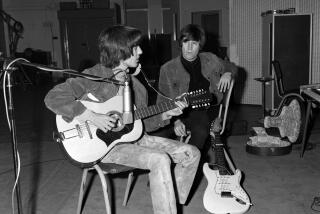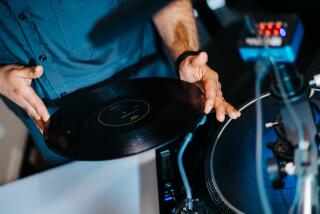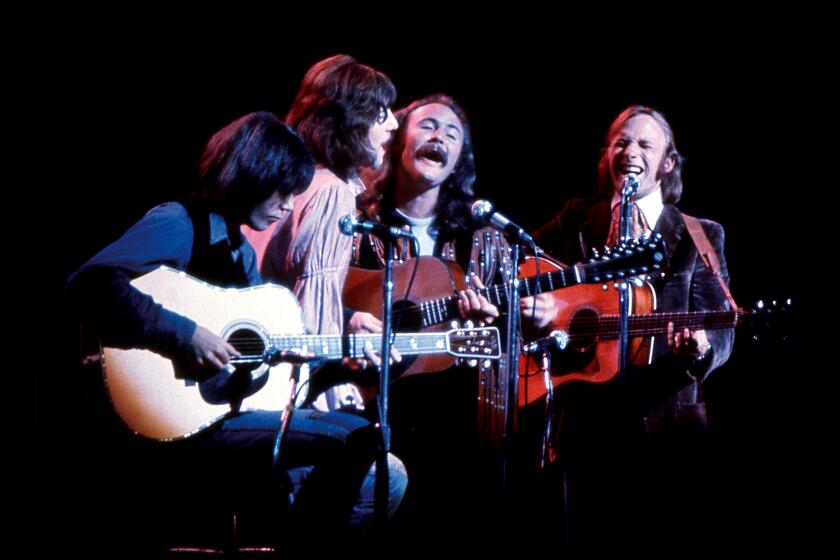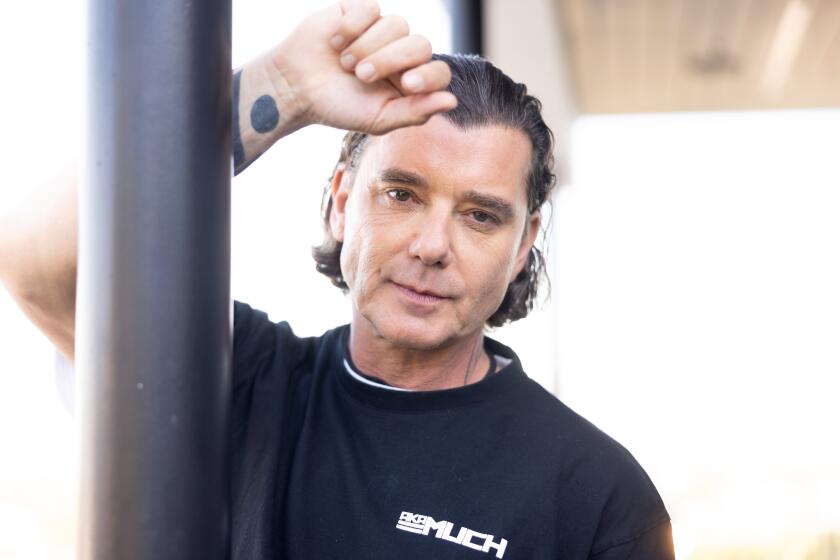The Beatles’ complete mono catalog released on vinyl LPs
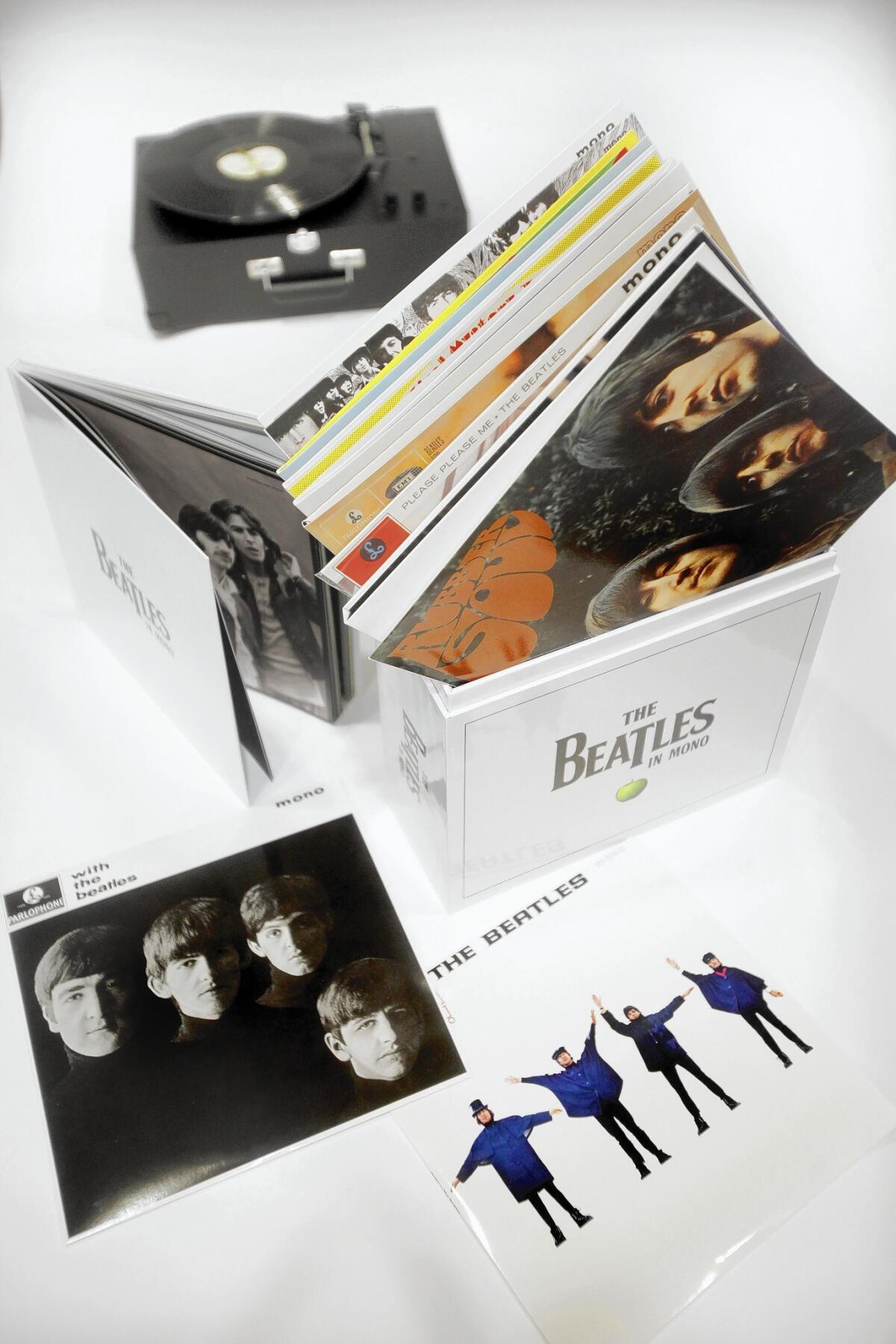
- Share via
In one sense, Tuesday’s release of the complete mono catalog of the Beatles on vinyl LPs is the most technologically ambitious attempt yet to take what is arguably the most significant body of recorded music in the pop era and do … absolutely nothing.
“This is a lot different than many other [reissue] projects,” said Steve Berkowitz, the lead producing engineer on the 14-LP “The Beatles in Mono” set. Berkowitz, who has overseen elaborate and meticulous restorations of vintage recordings by Robert Johnson, Miles Davis and many others, said, “The goal here was to replicate as closely as possible what their original intention was. The music didn’t get any better. It stayed as great as it was.
“If the ‘Mona Lisa’ is the final work of [Da Vinci’s] art, then the Beatles’ records that were released in the 1960s were the final work of their art.”
The new box set weighs a whopping 21 pounds, includes a 108-page book walking readers through the making of each album and is selling on Amazon.com for a hefty $375. And that’s without the “Yellow Submarine” soundtrack, “Abbey Road” and “Let It Be” albums, which came out after the Beatles and their label, EMI-Parlophone, belatedly adopted stereo as the preferred way to mix their music.
In addition to those original 10 mono titles, there’s a three-LP set featuring singles and other monaural tracks that did not appear on the studio albums.
It’s the final shoe to drop after the Beatles, their Apple Corps company and their label entered the digital era in 2010 by making their recordings available for download on iTunes, and subsequently releasing the complete catalog on newly remastered CDs.
Two years ago, “The Beatles in Stereo” box set made the music available once again on vinyl LPs, and now the mono box delivers the versions that were always closest to the hearts, minds and ears of John Lennon, Paul McCartney, George Harrison, Ringo Starr and producer George Martin.
Beatles historians are fond of pointing out that Martin and/or the Beatles often weren’t present when the stereo versions of their first 10 albums — “Please Please Me” in 1963 through the double-LP “The Beatles” (a.k.a. “The White Album”) in 1968 — were done and that those were usually whisked through the mixing process in a day or two.
“You always heard stories about how the second engineers were doing the stereo stuff, which kind of blows my mind,” said Chris Carter, host of the nation’s longest running radio show dedicated to the band’s music, “Breakfast With the Beatles,” which airs Sundays at 9 a.m. on KLOS-FM (95.5). “Everyone always said that the mono mixes were the ticket.”
The differences in many cases are surprisingly noticeable.
“She’s Leaving Home” from “Sgt. Pepper’s Lonely Hearts Club Band” and “Don’t Pass Me By” from “The White Album” are significantly faster — and the voices higher — in mono than in stereo. Starr’s famous scream of “I’ve got blisters on my fingers!” at the end of “The White Album’s” “Helter Skelter” is missing entirely from the mono mix. The transition from “Good Morning Good Morning” into the “Sgt. Pepper’s” reprise on Side 2 is drastically different.
All those elements, however, are evident on the previously released mono CDs. The difference between what people will hear on the LPs versus the CDs is more subtle. The salient question is whether that difference is worth $375.
“There are no translations to digital back to analog going on here,” Berkowitz said. “Analog is limitless—it doesn’t have to fit into a digital box. I like digital as much as I like analog, but the intention of these records is only realized in analog, because they made them in analog. People will feel it differently. There are sounds and feelings and spaces that the human animal reacts to , whether you know it or not. It’s innate in us in as animals.”
“For the average fan, it’s probably not that big of a deal,” said Neil Schield, owner of Origami Vinyl, the 6-year-old specialty shop in Echo Park. “People have had the stereo versions to listen to on vinyl, and for a lot of them that was probably good enough.
“As always with any legacy artist, there’s a way of looking at everything [the record labels] put out as just another cash grab. But from our perspective, we always want to hear the records the way we’ve grown up listening to them, or the way the band intended for us to hear them. … Ultimately, this is going to be the definitive set for Beatles fans new and old who want the mono records. And to us, that’s exciting.”
The issue of potential overkill is real, and other retailers have said they are cautiously gauging how much public interest there is in this latest iteration of the Beatles oeuvre.
“We’re not sure how big a deal it’s going to be until it gets here,” said Brad Schelden, the indie music and vinyl buyer at Amoeba Music in Hollywood. “The stereo LPs obviously were a huge deal, and we ordered 90 each” of the individual LPs and full box sets, he said. “We’re a bit more hesitant on this one. We’ve ordered about 15 of each.”
Universal Music Group, which assumed control of the Beatles catalog through its 2011 merger with EMI, is pressing 1 million vinyl LPs, a figure that includes all the individual titles (currently priced at $19.99 each on Amazon; $34.99 for “The Beatles” two-LP set) plus the 14-LP box sets, according to a UMG spokeswoman.
For the ultimate purist, audiophile cartridge maker Ortofon has created a special edition mono playback cartridge in conjunction with the vinyl release of the Beatles mono LPs.
It’s more expensive than the box set itself, retailing for $500, but Ortofon product specialist Louis Dorio says, “You will hear a dramatic difference with true mono playback. With a monaural recording, there is only lateral movement of the cartridge stylus. With a stereo recording, there is lateral and vertical movement. When that vertical movement of the stereo cartridge happens, it translates as distortion.”
The process of neither adding nor taking away from the sounds on the original master tapes has been no easy task for Berkowitz, lead Abbey Road mastering engineer Sean Magee and the team that’s been working exclusively on the LP set for more than a year.
Berkowitz noted that production of the vinyl LPs involves a chain of 11 intermediary steps between the original master tapes and the final product, each step of which could introduce changes, however minor, to the musical information encoded on tapes that rolled a half century ago. That encompasses the alignment of tape playback heads to the quality of the electric power supply itself.
The months-long attention to detail on multiple technical fronts is meant to create the clearest window yet through which to experience the Beatles’ musical journey.
“Without sounding like an advertising guy, I was amazed again at how brilliant it all is,” Berkowitz said. “To have those four guys, that producer and those engineers in that place — what a unique situation that was. They were such experts at it, and they all grew together.”
More to Read
The biggest entertainment stories
Get our big stories about Hollywood, film, television, music, arts, culture and more right in your inbox as soon as they publish.
You may occasionally receive promotional content from the Los Angeles Times.

